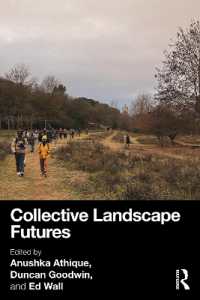基本説明
Advocates of representational gestures, meet advocates of speech. The present meeting resulted in contributions by 23 specialists in the behaviour and brain of humans, including comparative studies in child development and nonhuman primates, aphasiology and robotics.
Full Description
Vocalize-to-Localize? Meerkats do it for specific predators... And babies point with their index finger toward targets of interest at about nine months, well before using language-specific that-demonstratives. With what-interrogatives they are universal and, as relativizers and complementizers, play an important role in grammar construction. Some alarm calls in nonhumans display more than mere localization: semantics and even syntax. Instead of telling another monomodal story about language origin, in this volume advocates of representational gestures, semantically transparent, but with a problematic route toward speech, meet advocates of speech, with a problematic route toward the lexicon. The present meeting resulted in contributions by 23 specialists in the behaviour and brain of humans, including comparative studies in child development and nonhuman primates, aphasiology and robotics. The near future will tell us if the present crosstalk — between researchers in auditory and in visual communication systems — will lead to a more integrative framework for understanding the emergence of babbling and pointing, two types of neural control whose coordination could pave the way toward the word and syntax.
The contributions to this volume were previously published as Interaction Studies 5:3 (2004) and 6:2 (2005).
Contents
1. Foreword: Vocalize to Localize: How to Frame a Framework for two Frames? (by Abry, Christian); 2. Introduction: Vocalize to Localize? A call for better crosstalk between auditory and visual communication systems researchers (by Abry, Christian); 3. Vocalize to Localize: A test on functionally referential alarm calls (by Manser, Marta B.); 4. Mirror neurons, gestures and language evolution (by Fogassi, Leonardo); 5. Lateralization of communicative signals in nonhuman primates and the hypothesis of the gestural origin of language (by Vauclair, Jacques); 6. Manual deixis in apes and humans (by Leavens, David A.); 7. Neandertal vocal tract: Which potential for vowel acoustics? (by Boe, Louis-Jean); 8. Interweaving protosign and protospeech: Further developments beyond the mirror (by Arbib, Michael A.); 9. The Frame/Content theory of evolution of speech: A comparison with a gestural-origins alternative (by MacNeilage, Peter F.); 10. Intentional communication and the anterior cingulate cortex (by Benga, Oana); 11. Gestural-vocal deixis and representational skills in early language development (by Antinoro Pizzuto, Elena); 12. Building a talking baby robot: A contribution to the study of speech acquisition and evolution (by Serkhane, Jihene); 13. Aspects of descriptive, referential and information structure in phrasal semantics: A contruction-based model (by Dominey, Peter F.); 14. First in, last out? The evolution of aphasic lexical speech automatisms to agrammatism and the evolution of human communication (by Code, Chris); 15. Name index; 16. Subject index







